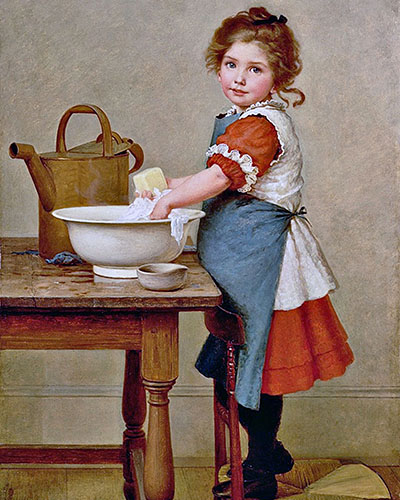According to this article, forty-four states are eliminating cursive writing as a requirement in public schools. Keyboarding will be required. I can understand the keyboarding being a requirement. I took typing in high school and will always be grateful I did as I had no idea how important computers would be in my future. But should this replace the need to learn cursive writing?
I’m personally of the opinion that children should learn to write in cursive and I have taught it as a teacher. As a homeschool mom now, I have Caroline do at least a little bit of handwriting every time we do school and she will eventually learn cursive when it is developmentally appropriate for her.
Writing, in general, is not her favorite activity, but I do feel there are reasons she needs to have a firm grasp of it both in terms of being able to write and read it. Even if we live in a technological society, there will always be a need for handwriting.
Does writing in cursive matter to you? If you homeschool, do you/will you teach it?
If your child goes to school, does it matter to you if your school eliminates it? Will you teach it to him/her if he/she doesn’t learn it at school?
Or is it just something from the past that’s no longer relevant?
















 Simplicity, Downsizing, Gifts, Children, and Christmas
Simplicity, Downsizing, Gifts, Children, and Christmas
Kyle, age 10, can write – print and cursive, his cursive is actually pretty decent. He HATES to write though, HATES it. He is a very creative child and I am trying to get him to write more, not handwriting but composition. I am going to let him start typing it all. He is doing a typing program and is getting pretty good at it. I also like the aspect of immediate spell check and him being able to correct his own work that way. So, that is where we are at with that. I think it is somewhat of a boy thing or personality thing too. Ellie, age 6, doesn’t complain about writing.
Having my children learn cursive handwriting is very important to me! My oldest two children attend a classical Christian school that puts a heavy emphasis on handwriting (among other things). My oldest son, who is in third grade, is learning cursive this year. What a delight it has been for us and his teacher to watch him beautifully excel in it… he has gorgeous cursive handwriting. For a child who has faced and still faces some learning challenges what a sweet, sweet mercy from God it has been for all of us to see him shine!
Our school still teaches it. (Catholic school)
I read somewhere learning cursive is good for your brain, it’s a totally different process than print. Very interesting stuff.
I used to be like you – a real stickler for it when I was a teacher in the public schools and beyond.
However, I now have 2 out of 3 kids who have serious issues that keep them from having pretty handwriting (print, cursive or otherwise). My oldest has aspergers and sensory disorders and she cannot write neat. AT ALL. As in, we’ve spent 11 years with tears and begging, pleading, punishing, screaming, being gentle – we’ve tried it all. She cannot produce “neat” writing.
Then, my middle daughter has an orthopedic disease and it’s impossible to write for long periods of time. We’re just thankful she can write at all.
My son is fine 🙂 and I hope he’ll have neat writing.
Handwriting has just become one of those hills I’ve stopped being willing to die on, if you will.
I actually have been pondering doing Cursive First with my younger students. I have read that it improves reading. My oldest has now almost completely switched over, and his cursive is MUCH more attractive than his ball-and-stick printing.
A child that cannot at least *read* cursive will not be able to work with original source documents (think here Constitution, Declaration of Independence, Mayflower Compact, etc.) because they are all in cursive.
In theory, I like the importance of cursive.
In reality, I was so traumatized by it when I was in school that I’ve pretty much neglected it in our homeschooling. I have workbooks on hand. Each of my kids have come to a point of wanting to be able to read/write in cursive and have been motivated enough to learn. . . and have decent enough handwriting to read.
Perhaps I should have overcome my own issues with handwriting for my children’s sake. . .
Perhaps they’ll be just fine with the learn-as-they-go method we’ve taken. . .
Lindsey – I would agree with you about children who aren’t capable of doing it or find it excessively challenging. That’s a completely different topic.
Brandy – I hadn’t thought of the source documents although I suspect that is becoming less and less important to the population at large. Why read them for yourself when you can just read a computer copy that’s been transcribed? (Yes, I’m being a little snarky. Sorry.) But you make a good point. Sort of like people who can’t understand classic literature because they have zero knowledge of the Bible.
TulipGirl – I think your approach is fine. Isn’t that what homeschooling is about? Doing things when the children are ready for it? I don’t think cursive writing has to start at a certain month of a certain grade.
Here’s a couple of articles I found:
How Handwriting Boosts the Brain
How Cursive Writing Affects Brain Development
The Many Health Perks of Good Handwriting
I agree cursive is good for the brain, the hand development and general concentration. Typing is good too and kids should have both. Good thoughts Sallie!
Ima
Our public school does not teach cursive . I am very disappointed about that . My 15 year old refuses to learn it or have any interrest in it ( she is the one who took over her own education basicly when she began kindergarten , mostly all As barely a question about anything ) The 13 year old we have spent so much time effort and money on just helping her to learn to read that even mentioning writing has sent her over the edge. (She is greatly improved this year now I wonder was it a natural growth process or hormonal spurt she needed to achieve to be able to read) or was it the thousands of $ and hours finally kicking in?? Anyway neither girl can read cursive which is unexceptable to me . I struggled greatly with being able to produce handwriting anyone could read when I was in school but now have very pretty handwriting if I do say so .Having just cleaned out my dear 82 year old friends effects I was able to see recipes and letters much of which wasn’t signed but we all knew who had written what simply by their handwriting. And the beautiful Spencerian writing is a work of art!!! What we are loosing in our rush to educate children to be efficient workers is the BEAUTY of life. And Beauty is not come by easily in art or architecture or music ,we have as a culture bought into the belief that all real beauty is what is natural or crude but just look at the wonderful things humans are able to create when they are disciplined it makes me feel a little thrill of creation and closer to God myself. Wow I kind of went overboard here didn’t I ?? LOL Karen
Karen said:
Amen! Well said! 😀
I have one of those sons who REF– USED to pick up any kind of writing utensil until the age of 6 when he started coloring and over time got quite good at it. He has some sensory motor issues and his hand tremors when he writes. There are other issues as well but the point is that he is a bright boy who has significant small motor skill issues.
This year he enters 1st grade. In Hungary. My expectations for him in handwriting has been low. My goal for him was simply to try and make a good effort to do well. He has far exceeded my expectations.
I taught in Hungarian schools for 4 years and was always shocked at how beautifully even the boys handwriting was. Now I know! They start cursive right away in 1st grade but don’t start right away with letters. They break down the letters into parts and practice writing those parts over and over and over again. THEN they start on the letters. It is amazing. My son just had a writing test. The grade he got on it was very low but that is only in comparison to perfection. In comparison to what he was doing 3 months ago(he literally could not draw a circle or stick person) it is a hands-down A+ and I am convinced will only get better.
Cursive is the way to go. If my son can do it, by far most children can!
Debbie – One of the articles I linked to in the comment above mentioned that most countries start cursive far earlier than the USA. I’m going to do some more reading and thinking about that. I would not have thought to start Caroline on cursive next year, but I’m going to keep an open mind about it.
I remember learning cursive and we spent a LOT of time practicing the strokes. I can still see the handwriting pages covered with arcs, etc. I doubt most schools would ever take that kind of time now for handwriting. It’s been so long since I’ve taught handwriting that I’m sure things have changed quite a bit.
Wow, Karen you are ON TO SOMETHING GIRL! Love your quote that Sallie highlighted.
Sallie- I said that cursive is the way to go but, as you know, it depends so much on the child. Even with the challenges he has, he has been motivated to work on his handwriting. Every day we write 2 or 3 lines and I am sure at school he does 2 or 3 as well. I try to take a Charlotte Mason approach and not force him to do 100’s of them but just a few well done. He does have a FANTASTIC, encouraging, supportive teacher as well which is not common here. As a parent sometimes I underestimate what my child can do.
Unfortunately, I cannot homeschool my kids anymore (long story, but God’s in control). We did practice cursive when we homeschooled and I still think it’s relevant in today’s world. I can see why the schools do not have time to teach it, especially now that they must teach keyboarding. But parents can’t drop the ball if at all possible. I still homeschool my kids in areas where I feel the public school doesn’t focus enough time. I’m their mom, after all. They do complain about cursive and don’t understand why they must learn it. But I know they will be the better for it.
I was saddened to learn that our PS system does not teach cursive. Then we purchased the mandatory school planner and found in the back a page or two about cursive handwriting. My little boy was so excited to start learning cursive, and he’s only in 1st grade. He can write his name in cursive, and I promised him that in a few years, I’d teach him to write cursive. Right now we need to focus on printing neatly!!
I value cursive writing and love it, and have taught it to my 3 daughters. But they hate writing in cursive…I don’t know why.:) I make my 2 current students write in cursive frequently anyway.:)
I am a public school teacher and I believe in cursive. It may sound silly, but if we stop teaching children cursive they will no longer have the ability to read historic documents. Not to mention the letters great grandma wrote to great grandpa during WWII. Sure they could read typed versions of those things, but they would lose the ability to read them *themselves.* I have a probelm with that.
The reason why many school are dropping cursive is time. States are adding so much to the school day – so many nore topics to teach and at earlier grade levels, something has to go, and schools see cursive as no longer essential so an easy thing to drop. I wish they wouldn’t. I certainly want my own children (who I will teach in school) to be able to read and write cursive.
Luckily my public school has not dropped cursive and we teach the d’nealian style of printing. D’nealian printing makes the transition to cursive MUCH easier. If you are not familiar with d’nealian, you should look into it.
http://www.dnealian.com/lessons.html
Our signature is a major factor in our life. ➡ If we only wrote in print, it would be so much more likely that our signature could be replicated and identities could be stolen 😯 , credit card fraud could happen more 🙁 , etc. And what if a postman had to deliver a letter that was addressed in cursive but he didnt learn cursive in school ❓ I see major benefits in learning cursive.
I know this is an older post but today my niece was talking to me about how her brother, who is 18 years old and now in college, cannot write any cursive at all and in fact cannot sign his own name. He simply puts the first letter and then squiggles a line behind it. I think technology is good but I dont think we should “dumb down” our children by not teaching them something as important as being able to sign your own name.
why do you think it is importent? you gave no awnswer on why. saying “it is importent” but not explaining why or how is simply Ipse Dixit, not truth. anything could be true if we allow reality to be defined by ipse dixit statements. let me explain my opinion and many reasons I hold it
my view on cursive depends on one key question, is it mandatory or not? cursive should not be required. it can and should be taught as an elective only. I think it should be learned by those who specifically express that they want to, but by no one else. I can give very detailed explanations of why I think that.
What exact purpose does cursive serve in the modern era? Seriously, teaching something just because it has always been taught is stupid.
Although, to be clear, my objection is to mandatory cursive, not cursive per say. Not everything should be required. There are many things I think people should be allowed to do, but I would oppose requiring people to do. That list includes many things I personally choose to do, and many I personally choose not to do. The reason for this is because I believe in freedom. If you want to mandate something you better have a compelling reason to do so, and also demonstrate how the mandate is essential in some way. there are things that are and should be desire dependent, those who want them should have them, but no other people should. to disagree with that is to accept the principle underlying totalitarianism. Never forget that when you put something in the elementary school curriculum you are in fact using government to mandate that everyone do it, regardless of if it benefits them, or if they even can, or if it actively harms them. My opinions on quite a few questions change solely because of that fact, and yours should as well. There are many specialist skills in this world, things people who work in specific fields need to know, but which it is a colossal waste of everyone’s time for most people. All the facts of the modern era place cursive in that category, no benefit of it has ever been proven. All claimed advantages are pure Ipse dixit* statements. From personal experience I know that many of them are flat out the opposite of the truth. Name a specific essential function of cursive that requires everyone to know it, as opposed to a few specialists. I say death to mandatory cursive, but long live cursive as an elective.
my opinion is that it is past time for cursive to become optional, not forbidden, but optional. cursive is no more relevant then Latin (and much less interesting too), and it amounts to the inflection of severe pain on many people. I have had an actual root canal, and it hurt significantly less then writing cursive. any perceived attack on cursive is meant to hurt mandatory cursive, not cursive per say.
CURSIVE SHOULD BE AN ELECTIVE ONLY. there are just not enough good reasons for it to be compulsory, but there more then enough for it to be offered, on the understanding and acceptance of the fact that many people will say no, but the interested will say yes. of course, I am a believer in the principle of a society that values freedom, so my default position on everything is that people are allowed to do something if they want to, but under no circumstance should they be mandated to do it; I require significant evidence to sway from that position, indeed if that is not how you are, there is no place for you in a society that values freedom. but anyway, Cursive has no role in modern life, and by the time anyone who is in school now is old enough to be employed, it will have even less of one my arguments against cursive include:
I. cursive takes forever to master, and some never will no matter hard they try
II. cursive is impossible to write good enough (and I define something as being written ‘good enough’ when it has been written correctly point where the letters are recognizable, though written imperfectly), cursive has to be perfected before it can be written legibly even to those who can read it, bad cursive may as well be doodles, and many people will never get good at cursive
III. some cursive letters look so different from what people see in books, on the internet, or in handwritten print; that I think that Greek or Cyrillic (Russian) alphabet letters are more obviously some type of letter then cursive is; this is true of even well written cursive; poorly written cursive (I. E. what most people who learn cursive because of education mandates wind up with) is indistinguishable from scribbles
IV. to many people; myself included, even attempting cursive amounts to the gratuitous inflection of severe physical pain; I have experienced an actual root canal, and it hurt a lot less then trying to write cursive; I am 100% serious when I say that I would rather be waterboarded then write cursive. the possibility of inflicting serious physical pain would be not much of a problem if it was only done voluntarily, but when something is mandated in the education system, you have people who do not want to do it being forced to.
V. too many cursive letters look like each other, making them hard to distinguish; which is of course harmful to anyone trying to read anything. this is the case even when written “correctly”,
VI. cursive only has advantages if your preferred writing instrument is a feather dipped in ink. I doubt the biggest cursive proponent has ever written with a feather and ink, and certainly does not do so regularly. not lifting the pen may be an advantage with feather and ink because those are hard to lift, can break easily, and can splatter ink all over; but no modern writing instrument has those properties. not lifting the pen slows you down because of the friction from the paper, and also having to go the same distances, and sometimes trace it. cursive became obsolete when the ballpoint pen was invented, that was in the late 1880s if you are wondering. you wanna talk about outdated
VII. cursive makes it so that you get tiered so much quicker
VIII. even most people who learn cursive abandon it the second it stops being required; which suggests there are a lot of better uses for everyone’s time
VIX. cursive makes dyslexia far far worse, in part because you can no longer make out the distinct letters. I think cursive set me back months in literacy.
X. cursive is slower, harder and less legible then print. print letter shapes are undeniably simpler, which makes them faster, easier and more legible, as well as requiring fewer strokes to write.
XI. handwriting is less necessary in the modern age in general, though to be honest I find this less compelling the above arguments, but why are we teaching 2 forms of something when it is debatable if we even need one? though I would say that if you want to save handwriting you should insist it become all print, but if you want to kill handwriting you should push cursive.
XII. cursive does in fact require very good handwriting to master, and some are born with the ability, some without it; some of those without will never acquire it, so it is actively cruel to force them to spend hours upon hours trying to get good at something they just cannot do, especially when the reasons for doing it in the first place are so tenuous. Cursive being in the schools was actually an attempt to create a sorting device between the haves who can spend forever perfecting a useless skill, and those who have not the time or motive. It is elitist prescriptivists who put it in the education system.
these are just some of the reasons cursive sucks. cursive proponents have no real arguments, and you did not even try to offer any, but what passes for the most common ones can be refuted as follows:
1. the general benefits argument: its benefits are wholly unproven, no study has even proven benefits of cursive specifically, the closest is demonstrating that handwriting generally has some benefits, but no distinction between cursive and print; I have read dozens of studies about the issue, and none back up cursive when you read what they actually say. every study cursive proponents quote turns out to be either misquoted, taken out of context, overtly lied about, or cites a source that engages in this behavior. often they do not cite the anything at all. rarely do they articulate what benefits they think cursive has. Ipse dixit statements just don’t work for convincing me of the benefits of something.
2. the speed argument: this one is based on a flat out distortion of fact if not full blown lies, and it doesn’t pass the smell test of truth either; I have found even illegible cursive to be incredibly slow, much more so then print. you want me to believe that adding a bunch of pretentious, ornate, intricate, and gratuitous loops, curls, tails, flourishes and curlicues to letterforms speeds up writing? how could anyone have so little common sense so as to think that? this one is exceptionally stupid, but to be sure, I checked the research, and there are studies that show that cursive can, for some people, but not others, be faster only if legibility is not a concern at all, but those same studies find that legible cursive is significantly slower then legible print, which shouldn’t be a surprise given all those ornate loops and curls cursive letterforms have; cursive is much slower compared to print of equal legibility. also I happen to find illegible cursive to be significantly slower then legible print, or even illegible print. did I mention that cursive cannot be written “close enough” (or good enough that you can read the letterforms though they are imperfect), whereas print can, cursive has to be perfected before it can be used
3. the historical documents argument: (this one covers things like the declaration of independence or the constitution) this one is especially ridiculous when you think about it, and let me explain why:
A. it is possible to know how to read something without being able to write it yourself (for example I can read Blackletter and Gaelic Script [which is not even typically used for writing English, though it can be used for that, outside of rare decorative inscriptions in Ireland, and a single house decoration my grandma owned; it never is, and never was; Irish Gaelic, by some accounts an endangered language is what is typically written in Gaelic script], but I will never be able to write either of them myself, in both cases my ability to read them is in fact better than I can read cursive; which I was years ago forced to waste excessive amounts of time learning to write, but no one ever bothered teaching us how to read); indeed many courses in dead languages like Latin focus on being able to understand what is already written in the language, not on being able to speak it or write it yourself; which makes sense when dealing with a dead language, for example there are not any ancient roman’s to talk to or listen to anymore, but there is still plenty of stuff they wrote that is perfectly available to read.
B. there are thousands of places you can find print versions of America’s founding documents, both hard copy and digital; some of the hard copies are from that era, those versions actually being what most people read, not the “originals”; and changing the font in which words are written does not change the meaning of them; if anyone asks I can show you some of those locations
C. the cursive versions of those documents are not in ‘modern’ (palmer style) cursive; but instead an older form known as “copperplate”, which is very different; also, the spelling is not the same as is typical today (for instance the constitution contains the words “chuse”, “Pensylvania”, “controul” and “defence” [that is how the document actually spells them]; among others); and they documents use the long s (an archaic form of a letter that cursive classes never mention even exists); add to that the fact that I have seen the originals of them for myself, and the writing is faded to the point of being barely legible; I could also add that the original version of the constitution capitalizes the first letters of common nouns, something that has vanished from English today, but should seem familiar if you have learned German as a foreign language like I have, but I think the point is clear even without that
D. reading the originals requires a trip to a specific room in Washington DC, which only a few people are able to do. and also, even if you can read cursive, you cannot read them in whole, as the displays they are on are permanently exposed to the first page only; so good luck with your impression of Nicholas Cage in the movie “National Treasure”; as that is the only way you will have the chance to read more than the 1st page of the originals; which you will be able to enjoy your new knowledge of them from prison, as stealing the original copies of the constitution or the declaration of independence is one of the most serious forms of theft from the US government possible, so expect to be on the FBI wanted list, for life, even if you somehow avoid jail; anyone dedicated enough to do all that will have certainly studied reading cursive enough to read it even if cursive is not taught in schools
E. even if this is a skill that is taught, it is so niche that it should be AN ELECTIVE ONLY, some will choose to take it, some will not; if there are still historians, archeologists, and linguistics scholars who can read Hieroglyphics, Ancient Greek, Latin, Old English, Sanskrit, and Cuneiform, we can be sure a few will take that class
in short, cursive is both not needed, and not enough to read those documents in the original; and should be consigned to an elective like Latin. there is a distinction between skills vital enough that everyone should have them, and those that a few specialists need (and can learn without forcing the rest of us to spend hours learning it)
4. the what if digital devices are unavailable/ fail argument: if that happens, we can use print handwriting, which is easier to read, easier to write, faster to write period in my opinion, and undeniably faster to write legibly, looks like what we see in books and on those digital devices; and which no one is seriously proposing getting rid of; many proponents of cursive seem to be conflating handwriting with cursive, when cursive is a single exceptionally difficult and pompous looking variety of handwriting; don’t confuse a single exceptionally ornate and outdated form of a concept with the whole of the concept. indeed if we just need handwriting and any handwriting will do, in the absence of a particular reason otherwise, it makes sense to use the easiest form of handwriting
5. the dyslexia argument: this one is simply false, I am mildly dyslexic myself, and cursive didn’t help me at all with spelling or writing, and in some ways made it worse. Cursive has more letters that look like each other then print does.
6. the signature argument: legally signatures do not have to be in cursive; they don’t even have to resemble your name. signatures can be printed, x marks, black letter, letters of the Russian alphabet, Chinese characters, a stick figure drawing of a cartoon character, a form of cursive other then palmer method (such as copperplate, Spenserian or Getty-Dubay) random squiggles, or something else; all that matters is that it is distinctive. most cursive signatures degenerate into squiggles anyway.
7. the letters from grandma argument: honestly, I find it unrealistic in several ways; for one I have never seen my grandparents write in cursive, ever. also, someone else can transliterate them. as mentioned previously, learning to read something does not absolutely require being able to write it yourself. also, I think grandma has a problem if she is sending people letters in a form of handwriting they cannot read, surely the burden should be on the person sending the letters to make them legible to the recipient. If they are addressed to someone else, then maybe its not our business to read them; that is debatable, but it should clearly prove why we should not have mandatory parts of the education system focused on allowing people to do that.
8. the beauty argument is ridiculous for several reasons. For one, there is much better out there, if you want beautiful looking letters, try Bengali as a foreign language. The letters of Bengali (especially, but not limited to “kô” the first letter in their equivalent of alphabetical order) blow even the best looking written English out of the water. if you have seen what Bengali looks like, you can’t possibly tell me that ‘b’s that look like ‘l’s, ‘n’s that sometimes look like ‘m’s, ‘q’s that look like 2s or z’s that look like a cut open human heart (or at least that is the closest describable thing they look like to me), or similar forms are better looking than Bengali kô, and you don’t have to be able to read or speak Bengali to think those letters are good looking. I included links to a galleries of bengali letters at the end of this comment in case you have never seen them (the first one is kô, the second is a gallery of the base consonants, the third is a gallery of the vowels in independent form [I. E. the way they are written when they occur at the start of a word], the fourth is what “kô” looks like with the markers to indicate vowel sounds besides ô attached, the fifth is a gallery of the conjunct consonants which are much more complex). if we want everyone’s writing to look pretty, we should learn Bengali, not cursive; but off that tangent. Two, most people’s cursive is truly ugly and awful, only a few people can write cursive in an aesthetically pleasing manner. Three, beauty is a subjective opinion, and mandates that apply to all should not be based on subjective opinions unique to some; I find the form of cursive taught in schools to be very ugly with the sole exception of the letters s and c (the former only when lowercase). Four, there is pretty looking print as well, for instance try Gaelic Type, I find it much prettier and more legible then cursive. Five, aesthetic concerns are not a good reason to mandate that all people put a lot of hard work into something. It would be different if only people who voluntarily chose too put the work in though, but cursive as an elective would meet that criteria, mandatory cursive does not.
9. the “creativity” argument: this one is absurd; you want me to believe a highly regimented and standardized process that is extremely difficult improves creativity? creativity is doing things in you own way, not conforming to a standardized model. More broadly, creativity cannot be forced, it happens spontaneously on its own, or it does not happen.
10. the “individuality” argument: this is the last argument, just phrased in a more absurd manner. Individuality comes from doing things your own way, as you see fit, without regard to how others do them. A highly regimented and standardized modal that everyone has to conform to (and make no mistake, that is how cursive is taught), is the opposite of that. To argue otherwise is to define the meaning out of the English language and say “up is down”, “large is small”, “black is white”, “life is death”, and “hot is cold”. Individuality can also never be forced, forcing someone to be an individual with mandates is a logical contradiction in terms. Mandates and requirements can only destroy individuality, never create it.
10. the “not hard argument”: this one is flat out false, at least for some of us; cursive in fact often takes a long time, some people may get it immediately, but others make take over a year of tedious practice for several hours a day, and still never get the hang of it. Cursive is in fact very hard, and takes forever to master. Print letter shapes are simpler, more constantly reinforced by seeing them in books, etc; and can be written “close enough”. Additionally even 15 minutes a day every weekday adds up to a lot of time, over the course of a month it already amounts to 5 hours.
11. the “knowledge” argument: this one could be used to justify a lot of things it is not used for. The language of Irish Gaelic is “knowledge”, should we mandate everyone in America learn that? Not bad mouthing Gaelic, I am doing a self-paced online course for learning it right now, and enjoying it; but that does not mean I think all the schools in America should require everyone to learn it. Reading hieroglyphs is also “knowledge”. So is knowing how to use an abacus, or shoe a horse. This has other applications, for instance it is knowledge to know how to burp exceptionally loudly. All the above forms of knowledge should be available for those who want them to obtain, but we should not spend 5 minutes requiring every single person to master them, which is what cursive in the elementary school classroom does. In fact there are so many forms of knowledge that if we required everyone to learn absolutely everything, no one would ever graduate, and the schools would last several times the human life span at least, and there would be no freedom anywhere. You don’t want that do you? When it comes to the knowledge we require everyone to have, we must be choosy. In my view only the essential stuff should be mandatory, the burden must be on proponents of something to prove why it is essential. Cursive supporters have not done that.
if you have any that are not subsets of those, tell me so I can knock it down.
I will concede that cursive does have the “advantage” of looking more pompous. on the other hand, the case against cursive included among other things, the freedom argument (that the default position is you are not required to, but can if you want to), but also the fact that we cannot teach everything to everyone, so the things we mandate everyone learn should be limited to things with clear benefits. additionally, there are hundreds of more relevant things that time could be used for. also, for many people (including myself, but others to an even greater degree) cursive is awful, they just cannot write it, and even trying causes significant pain. to people who struggle with long handwriting anyway, cursive is pure torture. It is an open question whether I would rather be water boarded or write cursive, I would have to think hard. and I know of people who have worse experiences with cursive then I did! I would prioritize peoples freedom from serious physical pain over what nostalgic luddites who don’t know what century they live in think looks good, at least when it comes to what people are required to do, even if you think it looks nice, it is grossly selfish not to in that situation. I am not necessarily calling for an end to cursive, I am calling for an end to compulsory cursive.
there are things that are and should be desire dependent, those who want them should have them, but no other people should. to disagree with that is to accept the principle underlying totalitarianism. all the actual facts in the modern era place cursive in that category. Cursive should be TAUGHT AS AN ELECTIVE ONLY. it is no more essential then Latin, and in my subjective opinion, less interesting (though I wholly acknowledge that even someone who agrees with everything else in this comment may disagree on the less interesting part). I am very confident that a substantial minority would take the elective. the people who are specifically interested, and no one else, should learn cursive. LET CURSIVE SURVIVE AS AN ELECTIVE!!!!!
I should add that if your daughter hates writing, chances are, forcing cursive on her will make her hate it more. cursive sacrifices everything practical in order to look more pompous.
*Ipse dixit is a phrase that refers to something that is asserted without any proof, or reason the thing is the case, or explanation of how the thing is the case. a statement of that type is dogmatically asserted and then one tries to opt out of logical argument all together. the term comes from a Latin phrase that translates as “he said it himself”, Cicero used the phrase to describe things simply dogmatically asserted. Anything could be true if we allow ipse dixit statements to define reality for us. Making assertions of that type is generally what cursive proponents are doing when talking about why it should be taught in a mandatory form. please note that most of these individual paragraphs contain far more detailed reasons as to why my opinion is the case then cursive mandate proponents have offered.
links to places to search for more information on things I mentioned above:
https://omniglot.com/writing/clogaelach.htm https://en.wikipedia.org/wiki/Copperplate_script#/media/File:Bickham-letter-detail.png https://en.wikipedia.org/wiki/Blackletter#/media/File:Old_English_typeface.svg https://en.wiktionary.org/wiki/%E0%A6%95#/media/File:Bengali_Letter_Ka.svg https://commons.wikimedia.org/wiki/Category:Bengali_letters#/media/File:%E0%A6%AC%E0%A6%BE%E0%A6%82%E0%A6%B2%E0%A6%BE_%E0%A6%AC%E0%A6%B0%E0%A7%8D%E0%A6%A3%E0%A6%AE%E0%A6%BE%E0%A6%B2%E0%A6%BE.svg https://en.wikipedia.org/wiki/Bengali_alphabet#/media/File:%E0%A6%AC%E0%A6%BE%E0%A6%82%E0%A6%B2%E0%A6%BE_%E0%A6%95%E0%A6%BE%E0%A6%B0%E0%A6%B8%E0%A6%AE%E0%A7%82%E0%A6%B9.svg https://en.wikipedia.org/wiki/Bengali_consonant_clusters#/media/File:Bangla_consonant_conjuncts.svg